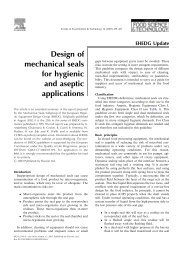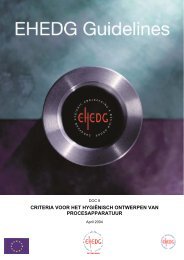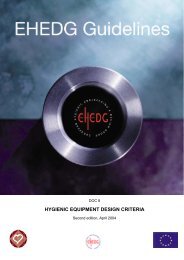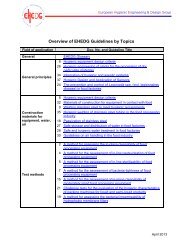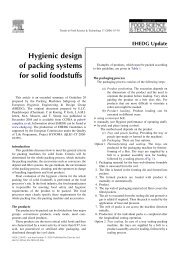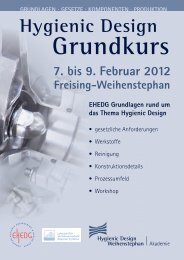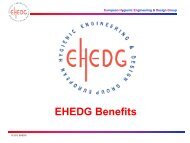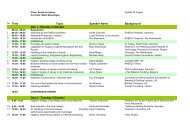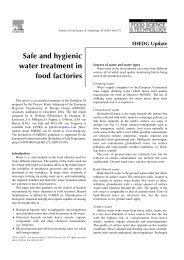Yearbook 2013/2014 - ehedg
Yearbook 2013/2014 - ehedg
Yearbook 2013/2014 - ehedg
Create successful ePaper yourself
Turn your PDF publications into a flip-book with our unique Google optimized e-Paper software.
170 EHEDG Subgroups<br />
EHEDG Subgroup “Materials of Construction<br />
for Equipment in Contact with Food”<br />
Eric Partington, e-mail: eric@effex.co.uk<br />
EHEDG Doc. 32 “Materials of Construction for Equipment<br />
in Contact with Food” offers practical guidance about the<br />
ways in which materials may behave such that they can be<br />
selected and used as effectively as possible. The Guideline<br />
is intended to serve as an aide-memoir during the design<br />
process, so that equipment manufacturers and end-users<br />
can together ensure that all aspects of materials behaviour<br />
can be taken into account in designing safe, hygienic, reliable<br />
and efficient equipment which can be operated, maintained<br />
and managed economically.<br />
The Guideline was first published in 2005. Its 54 pages<br />
addressed legislation, materials behaviour, hygienic design<br />
and cleanability. The materials covered included metallics,<br />
elastomers, plastics, composites, ceramics and glasses,<br />
and the characteristic ways in which each group of materials<br />
behaves were discussed. Potential failure mechanisms were<br />
identified, together with the conditions under which there is<br />
the greatest risk of them occurring.<br />
But since that first issue was written, much has changed in<br />
the world of Food Contact Materials including revisions of<br />
the Framework Directive and the Machinery Directive, new<br />
constraints on the selection and application of some nonmetallic<br />
materials, advances in composites, glasses and<br />
anti-microbial materials and the advent of nano-materials. It<br />
is now time for Doc. 32 to be reviewed and updated.<br />
A successful first meeting of the re-formed SG Materials of<br />
Construction was held on 27 June 2012. It established a<br />
base for the revision of Doc 32 ― the structure of the new<br />
Guideline would generally follow the format of the original,<br />
each group of materials (e.g: metallics, plastics, elastomers,<br />
ceramics) being discussed in its own separate section<br />
prepared by a small team of experts in those materials.<br />
The SG Materials of Construction currently comprises<br />
experts in legislation, metals, cleanability and some areas<br />
of plastics and elastomers but would welcome offers of<br />
assistance in the fields of ceramics, glasses, composites,<br />
anti-microbial surface treatments and biocidal materials,<br />
metallic surface coatings and intelligent materials where<br />
they apply to Materials of Construction. If you would like to<br />
participate in the updating of Doc. 32, the secretariat and the<br />
Chairman would be very pleased to hear from you.<br />
Chairman:<br />
Eric Partington<br />
Nickel Institute<br />
Well Croft<br />
Ampney St. Mary<br />
Gloucestershire GL7 5SN<br />
United Kingdom<br />
Phone: +44 1285 610 014<br />
E-mail: eric@effex.co.uk<br />
EHEDG Subgroup<br />
“Hygienic Design of Meat Processing Equipment”<br />
Dr. Aleksandra Martinovic, e-mail: aleksmartinovic@t-com.me<br />
In March 2011, the new EHEDG Subgroup “Hygienic design<br />
of meat processing equipment” again became active after a<br />
long period since the first kick off meeting held in Belgrade<br />
in 2009.<br />
The purpose of the subgroup is to develop a guideline to<br />
specify and illustrate the hygienic design of machinery<br />
and equipment used in the meat processing industry. The<br />
document will provide guidance by highlighting good and<br />
bad design examples as well as by describing installations,<br />
operations and maintenance of such equipment according<br />
to the state-of-the-art achievements in the field. The scope<br />
of the new EHEDG guideline in progress will focus on ‘Meat<br />
processing between slaughtering and packaging’.<br />
The subgroup consists of some 15 professionals from<br />
companies and institutions. This underlines the industry’s<br />
broad interest in the subject.<br />
Poorly designed equipment may increase the risk of<br />
contamination of food products such as meat and meat<br />
products with micro-organisms, and different stages of<br />
processing and manufacturing may demand different levels<br />
of hygienic design. The fundamental principle, however, is<br />
that the design of any piece of equipment must not allow any<br />
increase in the concentration of relevant contaminants.<br />
The guideline will cover the hygienic aspects of equipment<br />
design, engineering unit processes, transportation systems,<br />
production procedures, cleaning and disinfection procedures<br />
and specific environmental requirements.



